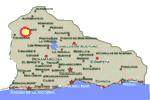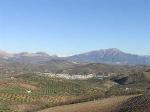data sheet
| Altitude | 400 m |
|---|---|
| Inhabitants | 2.700 |
| coast | 25 min / 33 km |
| Airport Málaga | 40 min / 40 km |
Location
The village of Riogordo, situated 400 metres above sea level, is located inland to the north of Málaga city. It is well served by a network of good roads, having direct access to the A356 which links Casabermeja with Velez-Málaga to the east. From Málaga via the N331 motorway to Seville/Granada, it is approximately 20 minutes to the A356 Casabermeja turn off. From here Riogordo is approximately another 20 minutes drive, passing Colmenar, its nearest neighbour, on the way. Access to the coast at Torre del Mar and the town of Velez-Málaga, capital of the Axarquía, is also straightforward with no more than a 25 minute drive along the A356, passing Lake Viñuela on the way.
Surroundings
The Riogordo landscape is a diverse one. To the north is the mountainous border of the Sierra del Rey and the steep clefts of the Alto de Gomer, one of the most beautiful areas around Riogordo. The land levels out as it descends towards the village – providing terrain more appropriate to cereal growing or pasture. All around the village itself the landscape is hilly and predominantly covered with olive groves and/or almond trees which form the basis of much of the local industry. Riogordo takes its name from the ¨heavy waters¨ of the Cueva river, due to the dragging down of rich minerals.
Riogordo´s town centre is very uneven and has few open spaces. It is divided into two distinct parts known as the Barrio Alto and the Barrio Bajo, or La Plaza. Most of the village´s old houses are built in the traditional style and many have internal patios, some with their own wells or barns and stables for keeping livestock.
History
It may have been the river which influenced the presence of the first settlers at Riogordo, who left their mark during the Neolithic era in the Tajos de Gomer. The oldest historical remains go back to the Phoenician era which left its tombs at the foot of the Sierra del Rey near the Auta estate. Nearby have been found the remains of Roman villas with rich mosaics from the 3rd Century. The Muslims built a fort at Auta and they influenced the urban outline of the present town, which became known as Riogordo in the 16th century, a time of great prosperity for the town. There are a number of homes in the village dating from the 18th and 19th Centuries. Many have niches housing statues of virgins, saints or the image of Jesus.
Features
Riogordo is famous throughout Spain for its annual re-enactment of The Passion and Death of Jesus Christ, called El Paso, which takes place at Easter every year. The parts are all played by locals from the village who all become actors for the day. The tradition dates back many years.
Properties in Riogordo
Riogordo
- Modern designed village house (69.000 €)
- Rustic finca with separate guest house (120.000 €)
- Modern and bright apartement (120.000 €)



